Would you like to make this site your homepage? It's fast and easy...
Yes, Please make this my home page!
Madrid at a glance
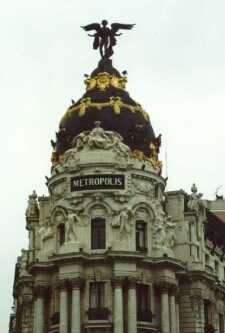


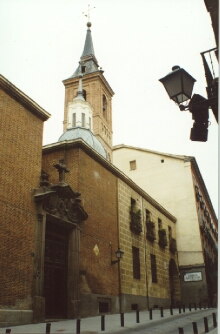
|
|
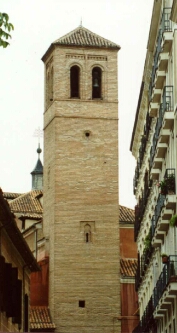
|
|
San
Nicolas
|
|
San
Pedro
|
The origin of Madrid is not associated with a place known as such,
but rather with an inhabited territory since Paleolithic due to it's
abundant hunting and water. It kept its ancient name of
"Matrice" (Mother of waters) through the Roman and Visigothic ages.
Madrid became a town with the arriving of Muslims. That was the way
they translated the primitive name for "Mayrit" which means, a stream between
two hills. In the year of 870 the Emir Muhammad the First ordered
to build a Castle on the top of one of those hills, mostly for military
reasons, because "Mayrit" was a major strategic point of defense
for the town of Toledo from Christians advance during the Reconquista.
In 1083 King Alfonso VI had conquered the fortress, however the lands of
Madrid weren't distributed among the feudal sirs, they were linked to the
royalty.
The
king's long ruling greatly contributed to the growth of the city. Due
to the good geographical location (situated in the center of Spain), the
Emperor Carlos I, transformed the Castle in a Royal Palace by establishing
good economical, political, cultural conditions. In 1561 his son, King
Felipe II, has declared Madrid a capital of Spain. King Carlos III, who's
reign began in 1759, became known as the best Mayor of Madrid for his
efforts in urban developments, embellishment, lighting and public cleaning
service. In 1808 Spain was invaded by Napoleon. On May 2th
of that very year, the people of Madrid rebelled against the French army.
Although the uprising was repressed, it the Napoleon Army wasn't able to
impede the fight that extended all over the country. It was
the beginning of the Guerra de la Independencia, and will finish in 1814
with the Spanish victory. When the King Fernando VII came back to Spain,
he gave Madrid the title of "Heroica" in addition to the older titles:
"Muy Noble y Muy Leal" in gratitude of people's courage. The
XVII century is known as the Spanish Golden Age because of the profitable
artistic creations. This converted Madrid into the main cultural center.
Painters such as Velázquez moved to the Court to realize his genius
work of art; the main writers come from Madrid and provinces, Cervantes,
Quevedo, Lope de Vega, Calderón de la Barca. Born the Spanish lyrical
sort par excellence, the Zarzuela, reaching the topduring c. XIX in Madrid,
"La Gran Vía" by Chueca or "La Verbena de la Paloma" by Bretón
are some examples of masterpieces. Finally, the XVIII century is mostly
known for the masterworks of famous painter Francisco de Goya, who expressed
the life and customs of the city, as well as the rebellion against French
army. Madrid, a city with its own heroes, legends and folklore, is an open
city to receive traditions from other Spanish provinces.
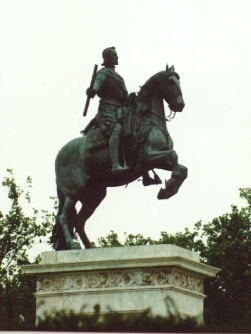
|
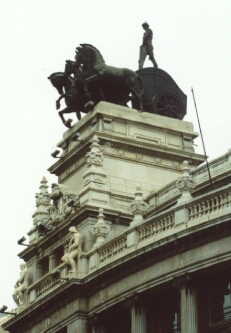
|
|
Plaza
de Oriente
|
Banco
Bilbao
|
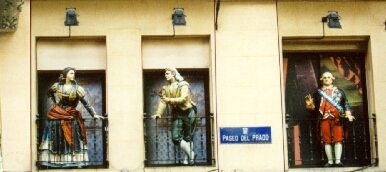
Madrid is a place to visit for: art and culture museums, such as
the Museo del Prado which is one of the most famous art galleries in the
World, churches, theatres, beautiful architecture, monuments like
the Puerta de Alcalá, wonderful places as the Plaza Mayor, the Paseo
del Prado or the Plaza de Cibeles, magnificent buildings, the Palacio
Real the Plaza de Toros de Las Ventas. There are numerous parks throughout
the city, the main being the Parque del Retiro. This is the city
where one can enjoy festivals and celebrations, bars and cafés and
excellent cuisine. Other interesting places to visit around the city: Alcalá
de Henares (Cervantes´ home town), Real Sitio de Aranjuez,
Monasterio de El Escorial, Valle de los Caídos, Chinchón,
as well as the beautiful landscapes of the Sierra de Guadarrama mountains,
which are excellent for skiing.

The legend
says that this tree in Retiro park was brought to Madrid from Mexico by
Hernán Cortés about 500 years ago!
Last up date 08/01/01
Photographs and Reviews ©
Paloma.
If you have any suggestions,
questions or comments click here to contact us at: PALOMA
. or.
LIZA.
Please don't use the translations
and photos without a permission.






